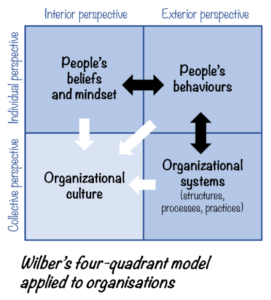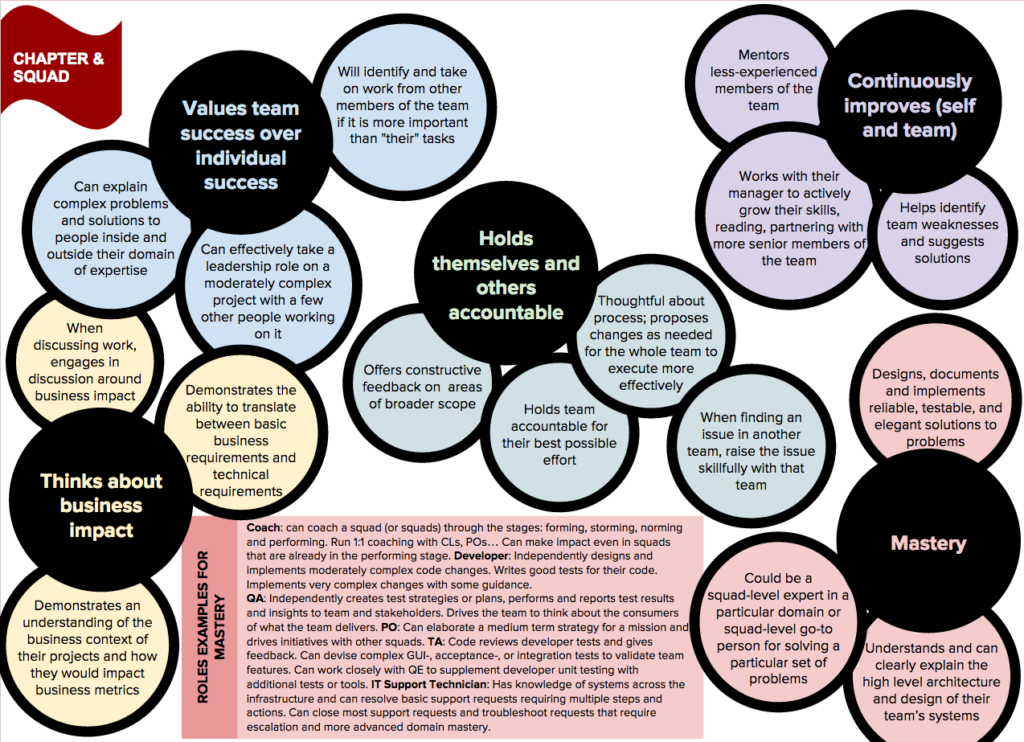4. Intentional org design
Why it matters
Management consultant and writer Peter Drucker is credited this famous quote:
Culture eats strategy for breakfast!
It is true that our values will shape our organizational design and our processes. If we try to introduce something there will be resistance if that change conflicts with our perception of who we are. The bigger the change, the stronger the resistance.
For example, if our core culture is one of collaboration and teamwork, we might have chosen to work according to Scrum since that framework emphasizes team collaboration.
However, the opposite is also true. New structures, habits and processes invite you to practice new skills and form new behaviours – which in turn will influence long-term mindset.
In other words – we do have the power to shape our culture.
How it works
Practice 1: Start with changing habits, not changing mindset

Laloux, the author of the book “Reinventing Organizations” applied Wilber’s “four quadrants” model in the context of organization culture. He argues that culture is the emergent summary of our beliefs, behaviours and structure. Our mindset will shape our behaviours, which in turn will make us prefer some structure over others.
But Laloux argues that it goes the other way too. New habits and routines will promote some behaviours and dampen others, and eventually reconfigure our beliefs and mindset.
John Shook, one of the first American managers hired by Toyota, had a similar experience. He learned the following from leading a dramastic cultural large-scale transformation at NUMMI:
Start by changing what people do, rather than how they think.
It’s easier to act your way to a new way of thinking, then to think your way to a new way of acting.
Another example – if we would introduce Scrum and invite people to work in teams and then hold them collectively responsible for their process and outcome, people will have to practice collaboration and master the skills of working towards shared goals (as opposed to practice skills that help them succeed with individual agendas). Through practice they will experience the power of mobilizing brainpower when planning, working and learning together.
Practice 2: Choose structure that promotes positive behaviors
There are always options. We can choose to address the same need with different strategies. When we introduce a new role, process or guideline we have to ask ourselves:
- What behaviours will this structure promote?
- What skills will people practice to be successful and to feel valued?
We should choose the structure that promotes the behaviours we want to see in our future culture.
Example:
Imagine that we have a lot of dependencies between our teams. Which is a common challenge in many organizations.
If we want to promote team ownership and self-organisation, we shouldn’t appoint a Dependency Manager that manages and addresses these dependencies. Why is that? Just imagine the skills that one would need to master to be valuable long term. If I’m too good at resolving dependencies, I wouldn’t be needed. So I might practice to look busy while actually working at a slower pace. I might practice secrecy to not reveal my current workload (hiding my short list of work) and painting a grimmer picture of the current mess to emphasize the importance of my work.
Another option is to hold a weekly “Dependency Resolution Speed Dating” meeting where representatives from each team attend. Teams take turn sharing if they are blocked waiting for something or expect a dependency coming up soon. If someone needs help we don’t move on until we have matched that team with a person (or team) that can help them forward. This would promote transparency, collaboration and caring for the bigger picture.
Practice 3: Be consistent with what you reward
Rewards come in many more shapes than just salary raises and promotions. It can be public acts of appreciation, kudos in the company slack channel, being mentioned and celebrated during an All-Hands meeting, flowers sent to the door, etc.
When you reward someone and show appreciation, make sure people are rewarded for the things that are presented as important.
Examples:
If you communicate that you value collaboration, make sure that that is reflected in your salary review process. Evaluate people on their contribution to the team, time spent supporting others and their ability to include others and for putting the shared goal of the team first – not for their individual performance or results.
If one of your company values is Innovation – don’t punish people for mistakes. Instead, show public acts of appraisal for those who have courage to experiment and fail and then share their learnings.
Avoid gaps between what you say and what you do. If you announce that this or that is important and valued, and then reward different behaviours – that will cause confusion and undermine peoples trust and confidence in you. It will also result in everyone trying to figure out what really matters, how they should behave and how to “win” when there are two versions of the rules – one public pretend version, and one secret set of rules.
Practice 4: Default to Trust and Transparency
Be cautious when you add bureaucracy and processes to ensure people don’t make mistakes or to prevent misuse of the system. This isn’t only consuming management resources, it also introduces slow decision making into your organization. Furthermore, the feeling of not being trusted to make responsible decisions is demovitational and makes us care even less.
Instead, start with the assumption that people can be trusted, that everyone wants to do a great job, are capable of making responsible decisions and want to succeed.
Being trusted is highly motivational and makes people want to do what’s responsible, as opposed to game the system for egoistic benefits.
Donald G. Reinertsen states in his book “The Principles of Product Development Flow: Second Generation Lean Product Development” that:
Decentralising control requires decentralising both authority to make decisions and the information to make them correctly.
Instead of having control mechanisms and approval processes, empower people to act on what they believe is right and the responsible thing to do. Furthermore, for people to make responsible decisions, they need access to data, thus you need to offer transparency.
Examples:
Don’t have a process for approving flight or train tickets. Instead offer guidelines of when travel is appropriate and make it transparent who travels where and how often.
Have open calendars. Configure it so that anyone can see what meetings others have. (For example, at the med-tech company kry/livi any employee can see which meetings the CTO has the upcoming week.)
Default to public documents, don’t make them private. Make it easy to search and find data, meeting notes, plans and metrics.
Record and share leadership strategy meetings. Empower everyone with the same level of understanding so that each person and each team can make responsible decisions for their context on a daily basis and drive their own roadmap.
Give everyone access to deploy code to production from day one. When things go wrong, conduct a Post-Mortem retrospective to learn how to improve testing, tooling, monitoring and how to make it safer to deploy code, and easier to roll back updates, in the future.
Practices 5: Celebrate results, but reward behaviours
Celebrate every success together and don’t miss any opportunity to learn from failures.
But in our VUCA* world that is unpredictable, complex and changing fast, success and failure is partly beyond our control. Sometimes we will fail even when we do everything right and work really hard. Due to lucky circumstances, we will sometimes succeed despite making some bad choices.
Reward positive desirable behaviours. How we act and respond is within our control and something we can change and improve over time.
The best example I can think of to explain what this can look like is Spotify’s Steps Framework. The framework has four steps (promotion levels) with five evaluation areas.

A key mechanism of the framework is that four out of five areas focus on behaviours and only one on performance and mastery. The framework is used for both continuous development one-on-one talks between the employee and the manager. It offers a promotional career path and offers salary bandwidth guidance.
In Spotify’s blog series about The Steps Framework we can read:
We have identified five sets of behaviours that provide a framework for understanding and talking about the expectations on all of us, at different levels of impact. They are:
Values team success over individual success
Continuously improves themselves and the team
Holds themselves and others accountable
Thinks about the business impact of their work
Demonstrates mastery of their discipline
The greater the impact, the more we expect in each of these areas. A “senior” technologist who’s helping to set company-wide strategy will need to make these values manifest in different (and more sophisticated) ways than a fresh-out-of-school member of a squad.
* VUCA = Volatile. Uncertain. Complex. Ambiguous.
Practices 6: Switch accountability to mitigate sub-optimization
Sometimes the emphasis on team autonomy and ownership results in sub-optimization, i.e. behaviours arise that benefit a person or one team short-term, but that in the long-term sabotage for other teams (or even the business).
One strategy to try out is to swap what teams are measured on in order to build empathy and to help everyone involved focus on the bigger picture and overarching goals.
Examples:
The software development teams were measured on and rewarded for the number of new features built, their output. The operations team were measured on and rewarded for production stability and uptime. Releases were rare and quality low. A decision was made to flip what the teams were measured on. The dev teams started being measured on production environment stability and the operations team on how many features were deployed. This resulted in the development teams investing more in test automation, performance and security testing and monitoring. The operations team created tools that enable development teams to easily and safely deploy their features as well as services for monitoring the health of production.
At a music streaming tech company, the leadership trio of a tribe were collectively responsible for the health and delivery of the Tribe, but individually accountable for different aspects of this. A few years ago a switch of accountability was enforced. The Tribe Product Lead was made accountable for the health of the teams within the Tribe and the Tribe Tech Lead accountable for delivery and meetings dates and milestones. This “forced” the Product Lead to care more about the long term health of teams, sustainable pace and psychological safety – not only spending time to rally the teams around a vision and communicating the importance of meeting targets and delivering on promises made to stakeholders. Sidenote: The agile coaches were also invited to the product organization since they now had a renewed curiosity about teamwork and agile practices.
References
Reinventing Organizations, Laloux Frederic, 2014
NUMMI: An American success story, Chicago Tribune, April 8, 2010
How to Change a Culture: Lessons From NUMMI, Shook John, MIT Sloan Review, 2010
NUMMI; what Toyota learned and GM didn’t, Gomes-Casseres, Benjamin, HBR, 2009
The Principles of Product Development Flow: Second Generation Lean Product Development, Reinertsen Donald G. , 2009
